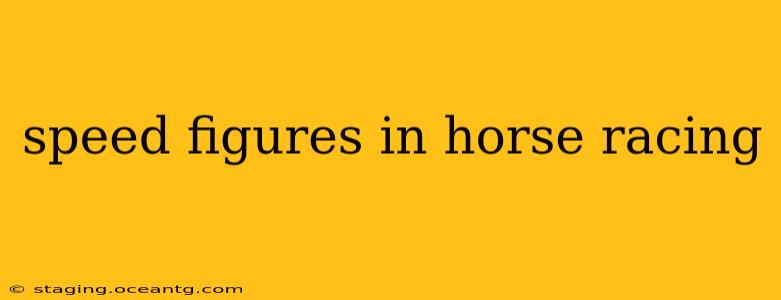Speed figures in horse racing are a crucial tool for handicapping and assessing a horse's performance. They provide a standardized numerical rating that allows for comparisons across different races, tracks, and even eras. Unlike simple finishing positions, speed figures offer a more nuanced understanding of a horse's ability, factoring in race conditions and competition. This guide will delve into the intricacies of speed figures, explaining their calculation, interpretation, and practical application.
What are Speed Figures?
Speed figures are numerical ratings designed to quantify a horse's performance in a particular race. They typically range from 0 to 150, although the exact scale can vary depending on the specific speed figure system used. Higher numbers represent superior performances. These figures aren't a direct measure of speed in miles per hour, but instead represent a horse's overall performance relative to other horses in the same race and the conditions of that race.
How are Speed Figures Calculated?
The precise calculation methods for speed figures are often proprietary and vary between different handicapping services and websites. However, most systems incorporate a multitude of factors, including:
- Finishing Position: A horse finishing first usually receives a higher speed figure than one finishing last.
- Race Track Conditions: The type of track (dirt, turf), its condition (fast, sloppy), and distance all affect the speed figures.
- Time of the Race: The faster a horse runs a specific distance, the higher its speed figure tends to be.
- Class of the Race: A horse winning a stakes race against top-tier competition will generally receive a higher speed figure than one winning an allowance race against lesser competition.
- Pace of the Race: A slow early pace followed by a fast closing kick will be considered differently than a race run at a consistently fast pace.
These factors are often weighted and combined using sophisticated algorithms to generate a final speed figure. The complexity of these algorithms accounts for the variations between different speed figure systems.
Are Speed Figures Reliable?
While speed figures are a valuable tool, they are not foolproof. It is crucial to remember that they are just one piece of the handicapping puzzle. Factors not fully captured by speed figures include:
- Specific Race Tactics: A horse might have a speed figure that underestimates its true potential if it was held back early in the race or experienced significant interference.
- Subjective Judgment: While algorithms are used, some subjective interpretation may be involved in the initial calculation and adjustment of the figures.
- Variations Between Systems: Different handicapping services will produce different speed figures for the same race due to variations in their algorithms and weighting of factors.
What are the Different Types of Speed Figures?
Many different entities generate speed figures, each with their unique calculation methods and interpretations. Some popular sources include Brisnet, Beyer Speed Figures, and Daily Racing Form. While these systems share underlying principles, there can be significant differences in the resulting numbers and their interpretations. Comparing figures from different systems directly can be misleading.
How to Use Speed Figures Effectively in Handicapping
Speed figures should be used as one piece of a comprehensive handicapping strategy. They should be used in conjunction with other factors like:
- Past Performances: Examine the horse's complete racing history, including speed figures from previous races.
- Trainer and Jockey: Consider the effectiveness of the horse's trainer and jockey.
- Race Conditions: Analyze the race distance, track conditions, and post position.
- Betting Odds: Understand the odds offered by the track.
By combining speed figures with other essential data points, bettors can form a more accurate assessment of a horse's chances of winning.
How Do Speed Figures Compare to Other Handicapping Methods?
Speed figures offer a more objective and quantifiable method compared to purely subjective analysis of past performances. They provide a standardized measure to compare horses from different races and tracks, offering a more nuanced perspective than just relying on simple finishing positions or raw times. However, they are not a replacement for thorough research and understanding of the many variables that can impact horse racing outcomes.
Can Speed Figures Predict Future Performance?
While speed figures offer insights into a horse's past performance, they cannot definitively predict future results. A horse's form can change due to injury, training, age, or other factors. Speed figures should be viewed as a helpful indicator, not a guarantee of future success.
This guide provides a comprehensive overview of speed figures in horse racing. Remember that mastering their use requires continuous learning and experience in interpreting the various factors that influence horse racing outcomes. Effective handicapping uses speed figures as one important tool among many.
